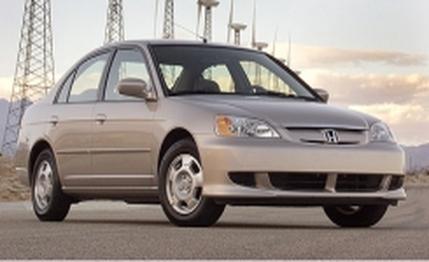 Road Test
Road Test
There's nothing quite as exhilarating as winding a Ferrari 360 Modena to its 8500-rpm redline with the driver's window down and the intake duct screaming in your left ear. But unless you're on a racetrack, you can't flog your Ferrari for long without accumulating a bundle of moving violations. If you want to flog a car continually, choose an economy special.
Allow us to nominate the 2003 Honda Civic hybrid for this duty. Now available in Honda showrooms, this new version of the Civic achieves 47 mpg on the EPA city cycle and 51 mpg on the highway cycle with the five-speed manual. With the optional CVT, it gets 48 mpg on both. Either way, that's about the same combined mileage as for the Toyota Prius, the only other gasoline-electric hybrid four-door sedan on the market.
Unlike the Prius, however, which is a unique vehicle dedicated to gasoline parsimony, this Civic is pretty much the same seventh-generation small Honda sedan that was introduced as a 2001 model. Its fuel efficiency comes from the addition of the gas-electric powertrain and a few minor tweaks.
Pop this Civic's hood, and you'll find a modified version of the Integrated Motor Assist (IMA) energizer introduced on the Insight two years ago (see sidebar). A thin electric motor, sandwiched between the gasoline engine and the five-speed transmission, provides up to 13 horsepower to boost the Civic's performance when necessary. During coasting and light braking, this motor also serves as a generator to recharge the Civic hybrid's nickel-metal hydride battery located between the rear seat and the trunk.
Think of this IMA system as an electric supercharger that provides additional performance without using much energy because it recovers the Civic's momentum to recharge itself. Coupled to the 115-hp gasoline engine in the Civic LX, the IMA would yield a considerable performance boost. But since Honda was after fuel economy, the IMA's extra power in the hybrid was coupled to a smaller, more efficient gasoline engine. Idle shutoff, under most circumstances, saves even more.
A further six percent or so of efficiency improvement comes from a few vehicle tweaks. A new front air dam and rear spoiler, along with revised underbody panels, reduce the drag coefficient from 0.30 to 0.28. Electrically assisted power steering reduces the parasitic losses on the engine, and special tires reduce the Civic's rolling resistance.
If all of this sounds like a variation on the Insight and Prius themes, you're not all wrong. But the Civic hybrid feels far more normal than the earlier hybrids, thanks to its more refined chassis. Its P185/70SR-14 Dunlop SP20FE tires, inflated to a moderate 30 psi, have none of the brittle hardness that seems to communicate every zit and dimple on the pavement to the interiors of the Prius and Insight. As a result, ride quality and road noise are vastly improved in the Civic.
The Civic hybrid also exhibits excellent straight-line stability, with none of the Insight's eagerness to be deflected from its path by side winds and worn roads. This chassis even delivers decent grip, with 0.81 g available in the corners before the front tires start grinding (adding a few psi to the front tires would likely boost the grip further). The ABS-equipped disc and drum brake combination stops the Civic hybrid in 191 feet and is plenty strong enough to deal with hard mountain-road driving, at least when the Civic is lightly loaded.